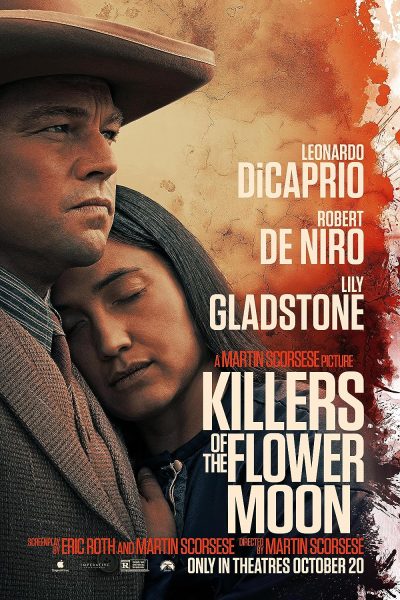
The unforgettable story of the “Killers of the Flower Moon” is once again making its return. This time, the story circulates in the more popular film and social media instead of within its contemporary history and literature media. Its story took its national stand in 2017 with the nonfiction novel, “Killers of the Flower Moon: The Osage Murders and the Birth of the FBI.” Within the past few months, its film counterpart had been announced to be released in late October, with audiences ecstatic with anticipation. After reading the book and seeing the film, I was just blown away by all the tense emotions and the gripping story.
The history of the Osage murders occurred in the early 1920s in Osage County in Oklahoma. The Osage tribe, who chose this land to move to, discovered one of the biggest oil reservoirs in the country. They became the richest Native American tribe and some of the wealthiest people at the time. The biggest friend to the rich Osages was William King Hale, a prominent and powerful cattle ranch owner and landowner. However, between 1921 and 1926, between 24 to 30 known murders occurred in Osage County (though the author of the novel, David Grann, suspects in his novel that there may have been as many as several hundred). Many were Osages with large oil headlights and some were private investigators looking into the murders.
When it seemed that no one could help solve this case, the Osage Tribal Council turned to the American government in desperation. The Bureau of Investigation (which became the FBI later on) was tasked with solving these murders. They came to Osage County under disguise as the local townsfolk. They collected enough information to pinpoint that there were several murderers, who were all hired by William King Hale. Hale was killing specific people in a linear order; when they died, their headrights would go from one person to the next until they would end up in his lap, since he was the most trusted, endeared and financially dependent friend of all the Osage. Hale was tried twice, but after several confessions from his assassins, he was sent to prison for life but released on parole in 1947.
The murders centers mostly around the family of Mollie Burkhart. She is the main historical person focused on in the film because her family has lost the most loved ones through Hale’s crimes. Her sisters and her mother were poisoned by the killers. Their headrights would go to Mollie and her husband, Ernest Burkhart. Mollie had diabetes, and during this time, insulin was a new drug.
The doctors would give Ernest the insulin to give to Mollie, but before he did, he would add a poison. That way, with Mollie dead, and their children to be murdered soon, Ernest would have all the headrights. They would then go to his uncle and inheritor, William Hale, if Ernest would die, as well.
Around this time, the Bureau of Investigation had enough evidence against Ernest, the other killers, and Hale to arrest them. It was Ernest’s confession and testimony which brought down all of Hale’s schemes and convicted most of the killers and Hale. (Hale had some of them executed to try and cover his tracks.)
The novel is written in narrative nonfiction, centered from an investigative perspective detailing the history of the Osage and their riches, the murders and the facts of the case, the side of the Bureau and how they approached and solved the investigation, and how the trials played out. In other words, the novel is a sole and undisputed fact. It covers every crucial angle of the murders that has been documented. There are historical photos of the victims, the killers, Hale, private investigators, members of the Bureau and anyone else who ties into these events.
The film isn’t a documentary and doesn’t only rely on the facts to tell the story. It tells the story from fictional scenes of Hale and his hired conspirators, from the private life of Ernest and Mollie and from the murder scenes. It tells the story from the side of the closed door, which hasn’t been documented in political and criminal dossiers and in David Grann’s novel. Many of these scenes are fabricated, based on what is known about the case. This makes the film feel kind of fictional.
However, the order of the scenes is akin to the novel and real life. For example, the novel reveals the facts of the murder of Mollie’s sister, Anna Brown: where she was murdered and where her body was found, the fact she was drunk, her being with Ernest’s brother, Brian (another one of Hale’s killers) and an unidentified third man who is revealed to be the one who killed her. The movie takes the liberty of adapting these facts into as close to a realistic reenactment as possible.
Historical documents about Anna were studied for Cara Jade Myers, who played Anna, to bring them to life as best as possible, as in how she moved and what she would have said that wasn’t written down. Other examples are conversations between Hale and Ernest being fabricated based on the details of real events and their characters.
Despite these liberties, director Martin Scorsese, actors Robert De Niro (who played Hale), Leonardo DiCaprio (who played Ernest), and Lily Gladstone (who played Mollie), and the rest of the cast and crew, worked with the Osage community to bring the most authentic retelling of the story as best as they could. They even shot the movie in Osage County and built the sets from what they looked like in the 1920s.
I believe the novel is better. I prefer the historical retelling of the novel more than the fictionalizations in the film. For instance, Robert De Niro is forty years older than William Hale was when he masterminded these plots, and it shows when comparing him to the photos of Hale. However, Scorsese understands where this movie’s place is at, though.
The ending of the film shows an Osage tribal dance in the form of a flower from an aerial view. This film honors the Osage people; it tells a story, which should have never been swept under and should never be forgotten. Even though the book deserves to be remembered and appreciated more, I feel the movie should also be seen to understand the emotion of the horror.



